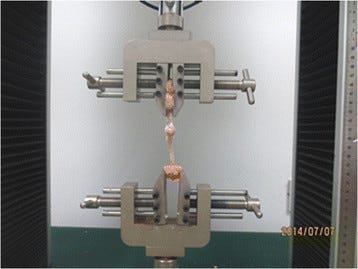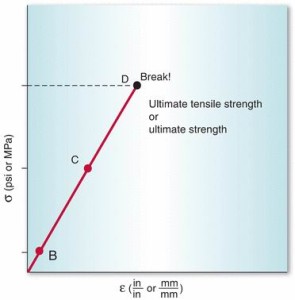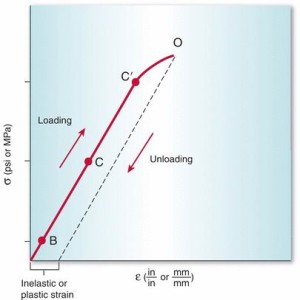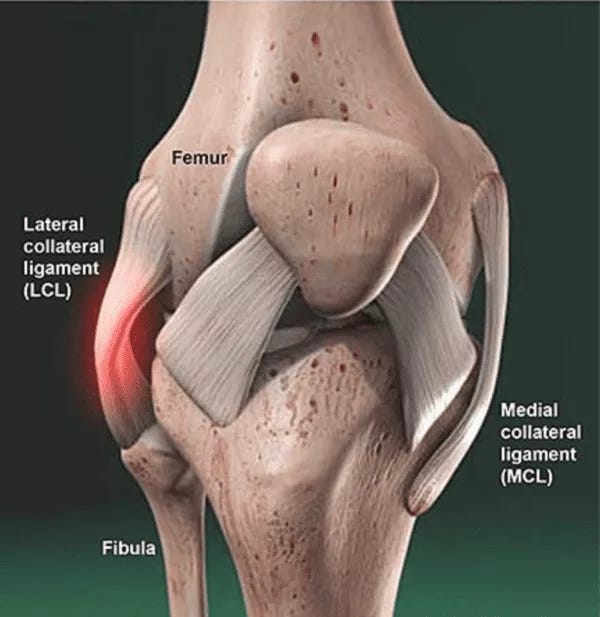
Oatis (2016) stated that there are over 1000 types of properties, which describes a material’s behavior in the presence of mechanical forces. Such material properties can be applied to human tissue (i.e., biomechanics), as a means of comprehending the body’s responses to the aforementioned mechanical forces. Such properties include, but are not limited to: stress-strain, Young’s modulus, load to failure, and loading rate (Oatis, 2016). As a means of understanding and appreciating such material properties, the following will explore load to failure in greater detail.
Load to failure describes the behavior of a material as it is progressively stressed and strained. Specifically, “failure” might be thought of as the condition of a material after loading, such that the specimen no longer functions as it was designed (Oatis, 2016). One load to failure outcome can be defined colloquially as the largest pulling (i.e., tensile) stress (measured in pounds per square inch-PSI) that a material can withstand just before it breaks. Additionally, both stress and strain follow a straight line until said point is reached (aka brittle failure) (Oatis, 2016).
Common biomechanical terminology, which describes the aforementioned behavior, would be ultimate tensile stress, ultimate tensile strength, or ultimate strength; all terms are synonymous with each other (Oatis, 2016). The following graphic shows the relationship between increasing loads to the point of the material breaking (identified as point D):

The second possible material response from incremental stress-strain loading is inelastic, or plastic, deformation (Oatis, 2016). Unlike brittle failure, a specimen exhibiting plastic deformation does not break. Rather, plastic deformation can be thought of, in colloquial terms, as a material “stretching” as it is pulled on each end, while maintaining the stretched position and shape, after the pulling has ceased (Oatis, 2016). The biomechanical definition of plastic deformation noted discordance between stress and strain; after loading of the specimen ceased and returned to zero, the strain (i.e., the change in length of a specimen divided by the original length) did not. That is, the specimen achieved a new, permanent, length/shape making it a plastic deformation (aka ductile) (Oatis, 2016). The point just before the specimen begins to exhibit plastic deformation is known as the yield point (point C’ in the graphic below) The following graphic shows the relationship between increasing loads to the point of the material reaching plastic deformation (identified as point O):

Load to failure concepts have direct implications on stability of joints in the body. If knee joint ligaments, for example, become lax from injury (i.e., the lateral and collateral ligaments), it has been known to induce more stress and strain upon other ligaments within the knee that have been reconstructed (i.e., anterior cruciate ligament and posterior cruciate ligament). Such a scenario deepens the probability of knee instability and development of further injury/re-injury (Wilson, Deakin, Payne, Picard, & Wearing, 2012).

Wilson et al. (2012) examined the mechanical properties of the knee ligaments, with specific emphasis on the lateral collateral ligament (LCL). This author derived particular interest from the researchers’ findings on ultimate strength outcomes of LCL stress-strain tests; such research allows one to better appreciate the importance of finding suitable graft choices for LCL reconstruction. If a graft from another tendon or ligament of the body has an ultimate strength measure lower that that of the LCL, it is likely that the LCL graft may fail under stresses lower than that of the original, uninjured LCL (Wilson et al., 2012).
As the purpose of the researchers’ article was covered, a brief summary of the methods and results will follow:
Methods: Wilson et al. (2012) used 5 elderly female and 5 male cadaveric medial collateral ligaments (MCLs) and LCLs in a tensile test. Preparations were mounted with custom aluminum grips in a uniaxial material testing machine. After incremental loading to failure, structural properties recorded of the MCL and LCl ligaments included: stiffness, yield strength, ultimate strength, and failure energy (Wilson et al., 2012).

Results: As mentioned in the previous section, Wilson et al. (2012) examined stiffness, yield strength, ultimate strength, and failure energy of the LCL and MCL. Additionally, test outcomes were compared and contrasted between the two aforementioned ligaments. In addition to understanding stress-strain tests of the LCL, and its implications in choosing grafts from other parts of the body, other results were revealed: the MCL is 2 times as strong as the LCL, and requires 3 times more energy to rupture. However, despite obvious differences in size, the LCL and MCL have similar tensile stiffness (Wilson et al., 2012).
Understanding load to failure concepts within the context of biomechanics, allows one to not only appreciate the behavioral changes of specimens under loads. Such analysis also has practical implications; knowledge of load to failure properties of various tissues increases one’s vigilance when choosing and harvesting a ligament for LCL (or any ligament) reconstruction. Ultimately and most importantly, the aforementioned choices, by default, have direct influence on the health, performance, and longevity of the knee, and the well being of the patient.
References
Oatis, C.A. (2016). The mechanics and pathomechanics of human movement (3rd ed.). New York, NY: Lippincott Williams & Wilkins.
Wilson, W.T., Deakin, A., H., Payne, A.P., Picard, F., & Wearing, S.C. (2012). Comparative analysis of the structural properties of the collateral ligaments of the human knee. Journal of Orthopaedic & Sports Physical Therapy, 42(4), 345-351.
-Michael McIsaac
